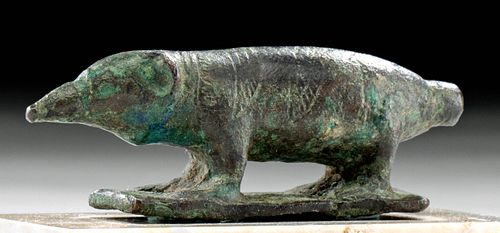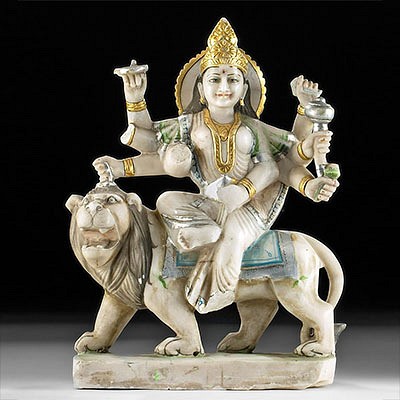Egyptian Bronze Votive of a Shrew (for Sarcophagus Lid)
Lot 7b
About Seller
Artemis Gallery
686 S Taylor Ave, Ste 106
Louisville, CO 80027
United States
Selling antiquities, ancient and ethnographic art online since 1993, Artemis Gallery specializes in Classical Antiquities (Egyptian, Greek, Roman, Near Eastern), Asian, Pre-Columbian, African / Tribal / Oceanographic art. Our extensive inventory includes pottery, stone, metal, wood, glass and textil...Read more
Categories
Estimate:
$900 - $1,200
Absentee vs Live bid
Two ways to bid:
- Leave a max absentee bid and the platform will bid on your behalf up to your maximum bid during the live auction.
- Bid live during the auction and your bids will be submitted real-time to the auctioneer.
Bid Increments
| Price | Bid Increment |
|---|---|
| $0 | $25 |
| $300 | $50 |
| $1,000 | $100 |
| $2,000 | $250 |
| $5,000 | $500 |
| $10,000 | $1,000 |
| $20,000 | $2,500 |
| $50,000 | $5,000 |
| $100,000 | $10,000 |
| $200,000 | $20,000 |
About Auction
By Artemis Gallery
Jul 16, 2020
Set Reminder
2020-07-16 10:00:00
2020-07-16 10:00:00
America/New_York
Bidsquare
Bidsquare : Ancient / Ethnographic Art Through The Ages
https://www.bidsquare.com/auctions/artemis-gallery/ancient-ethnographic-art-through-the-ages-5334
Ancient art from Egypt, Greece, Italy and the Near East, as well as Asian, Fossils, Pre-Columbian, Native American, African / Tribal / Oceanic, Spanish Colonial, Russian Icons, Fine art, much more! Artemis Gallery info@artemisgallery.com
Ancient art from Egypt, Greece, Italy and the Near East, as well as Asian, Fossils, Pre-Columbian, Native American, African / Tribal / Oceanic, Spanish Colonial, Russian Icons, Fine art, much more! Artemis Gallery info@artemisgallery.com
- Lot Description
Egypt, Ptolemaic period, ca. 332 to 30 BCE. A charming cast-bronze figurine of a shrew atop an integral lid meant for a votive sarcophagus. The petite mammal stands atop four attenuated legs and has a bulky body, a protruding tail base, and a slightly tapered neck. Circular eyes, a puffy mane, a tapered snout, and a pair of cupped ears comprise the countenance. The back of the neck is incised with a serrated register similar to the designs seen on pharaonic Wesekh pectoral collars and incised on the back are a pair of outstretched wings symbolic of the goddess Isis. Mottled layers of green and brown patina envelop the entire composition, and areas of azurite patina are visible on the head and neck. Size: 3.1" L x 0.8" W x 1.1" H (7.9 cm x 2 cm x 2.8 cm); 1.4" H (3.6 cm) on included custom stand.
According to scholar Dorothea Arnold, "'The Voracious' was the ancient Egyptians' name for the shrew, an epithet that aptly describes the feeding habits of this tiny animal. In ancient Egyptian popular mythology the shrew was closely associated with the ichneumon. The shrew represented the blind aspect of a solar deity whose complement, endowed with keen eyesight, was understood to be the ichneumon." (Arnold, Dorothea. "An Egyptian Bestiary." The Metropolitan Museum of Art Bulletin, Spring 1995, Vol. LII, no. 4, p. 39).
For a nearly identical example, please see The Metropolitan Museum of Art, accession number 04.2.465.
Provenance: private East Coast, USA collection, acquired in February 2019; ex-Artemis Gallery; ex-private New Jersey, USA collection
All items legal to buy/sell under U.S. Statute covering cultural patrimony Code 2600, CHAPTER 14, and are guaranteed to be as described or your money back.
A Certificate of Authenticity will accompany all winning bids.
We ship worldwide and handle all shipping in-house for your convenience.
#152792Loss to end of tail as shown. Small area of restoration to one side of body, with resurfacing and overpainting along new material. Minor abrasions to plinth, body, head, and legs, with softening to some incised details, and light encrustations. Great brown and green patina throughout with areas of azurite patina around head and neck.Condition
- Shipping Info
-
All shipping is handled in-house for your convenience. Your invoice from Artemis Gallery will include shipping calculation instructions. If in doubt, please inquire BEFORE bidding for estimated shipping costs for individual items.
-
- Buyer's Premium



 EUR
EUR CAD
CAD AUD
AUD GBP
GBP MXN
MXN HKD
HKD CNY
CNY MYR
MYR SEK
SEK SGD
SGD CHF
CHF THB
THB














